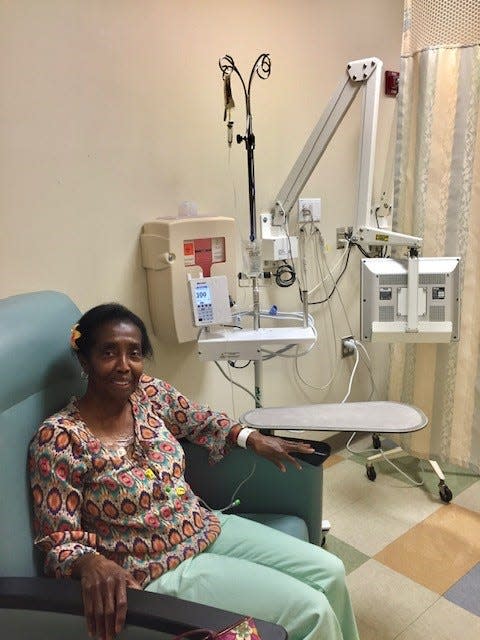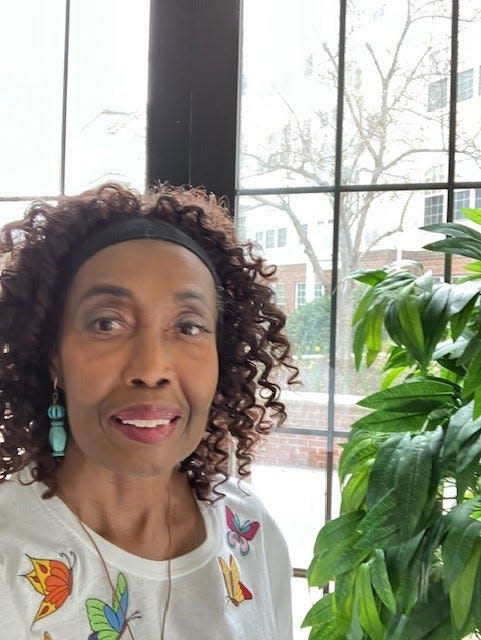Blood cancer multiple myeloma, once a death sentence, is now highly treatable. Here's why
After Judith Harding was diagnosed with multiple myeloma in 2009, she decided to retire, sold her condo, dropped out of her PhD program and moved nearer to her family, preparing to "live out my last days."
When Bill McHugh received a stem cell transplant to treat the same type of blood cancer in 2013, he shared the ordeal with three fellow patients with a similar prognosis, also going through a transplant. Only McHugh defied the odds by surviving more than a few years.
McHugh and Harding once would have been outliers. But now, thanks to treatment advances that have come over the last few years and as recently as this month, both are typical rather than exceptional multiple myeloma patients.
“The steps we’re making are exponential,” said McHugh, now 59, of New York City. “We went from the wheel to the Tesla to flying cars.”
House Majority Leader Steve Scalise announced Tuesday that he'd been diagnosed with multiple myeloma and that it was "very treatable." Newscaster Tom Brokaw also has the disease, and actor Roy Scheider, General Colin Powell and former vice presidential candidate Geraldine Ferraro all had it when they died.
The disease officially remains unpredictable and dangerous. But with drug combinations and immunotherapies, today’s patients can realistically dream of a disease-free life.

Dr. Sundar Jagannath, a multiple myeloma expert at the Icahn School of Medicine at Mount Sinai, in New York, said he can now tell a 75-year-old, newly diagnosed patient they are unlikely to die of multiple myeloma.
“Bringing life expectancy for an elderly patient to a normal life expectancy, as if he didn’t have cancer, is in a way a cure,” said Jagannath, who directs the Multiple Myeloma Program at Mount Sinai's Tisch Cancer Institute.
For younger patients, median life expectancy is 10 years or longer, he said.
Newer treatments are being delivered earlier in the disease course, improving their effectiveness, and more drugs are coming through the pipeline.
"If I make you live for the next 5 to 10 years, the cure is in your lifetime," Jagannath said.
"A hopeful moment:' Revolutionary leukemia treatment in fight against solid tumors
Multiple myeloma in detail
Multiple myeloma is a cancer of plasma cells, cells that are responsible for making antibodies that help the body fight infection after a vaccine or help provide protection after an infection.
When these plasma cells turn cancerous, they can crowd out healthy cells, causing anemia, damaging bones and triggering kidney failure.
About 35,000 Americans are diagnosed with multiple myeloma every year. The majority are ages 65 to 75, though it can strike at any age.
The second-most common blood cancer in the U.S., multiple myeloma occurs twice as often and 5 to 10 years earlier among people who are African American as among those who are Caucasian.
Survival is the same for people of all races and backgrounds when treatment is the same, said Dr. Sagar Lonial, the chief medical officer of the Winship Cancer Institute of Emory University in Atlanta.
"If all patients get access to good modern myeloma care, the outcomes can be better for everybody," he said.
Symptoms are common to many other conditions, making multiple myeloma difficult to diagnose. Frequent ones include: fatigue, back pain, bone pain, recurring infections, weakness, fatigue, shortness of breath and blood cell counts.
Lonial said people should see a doctor if they have back or bone pain that is getting progressively worse or other progressive symptoms including unexplained anemia or kidney problems, particularly people who are African American as the incidence of myeloma is higher among African Americans.
McHugh, who works in product development for Bloomberg, had no symptoms at all. His cancer was discovered in a routine medical check which showed elevated protein level in his blood.
Harding, a learning disabilities specialist and mentor, first noticed fatigue and rib pain. Even a simple task such as writing on the blackboard got increasingly painful. She dismissed both as symptoms of her busy lifestyle as an educator and a PhD student.

"I always thought I was just doing too much." Cutting back on her social and academic life didn't seem to make a difference, though. "I thought I would start to feel better. That didn't really happen."
Advancing by inches, then leaps
It took decades to identify and integrate stem cell transplantation and high-dose chemotherapy as key treatments, but the pace picked up with the approval of individual drugs and then a combination of them, said Kathy Giusti, an early patient who co-founded the Multiple Myeloma Research Foundation, which helped fund and champion many of the treatment developments over the last two decades.
First, in the early 2000s, there was a three-drug regimen with Revlimid (sold generically as lenalidomide), Velcade (Bortezomib) and dexamethasone, then in 2018 as a four-drug combination with the addition of Darzalex (daratumumab).
Immune therapy has made a profound difference for multiple myeloma patients, just as it has in many other cancers. Several types of therapies that turn the immune system against multiple myeloma have shown an ability to destroy cancer cells and to "remember" what those cells look like and kill any similar ones that pop up in the future.
"In myeloma we've always known that the immune system plays a critical role," said Giusti, whose own life was saved, in part, by a stem cell transplant from her identical twin sister, giving her a new immune system.
With so-called CAR-T therapy, a patient's own immune cells are removed and engineered in a lab to target cancer cells before being given back.
Doctors are getting so much better at managing the side effects of this therapy it can even be given to older or frail patients, transforming their prognosis, Lonial said.
Harding, of New Jersey, received CAR-T in January and "by God's grace, I came out of CAR-T with flying colors," she said.
It's next on McHugh's treatment list, too.
"I look at this as being a potential near-cure," he said.
The newest multiple myeloma approaches
The two therapies approved this month are called bispecific antibodies, advanced forms of immunotherapy that essentially grab tumor cells with one hand and immune soldiers with the other and bring them together so the immune cells can accurately target the tumor.
Elrexfio (elranatamab), from Pfizer, will have an initial monthly price of $41,500, dropping in half after six months when the dosing is switched to every other week. Earlier in the month, the Food and Drug Administration approved a similar drug from Janssen Biotech, a Johnson & Johnson company, called Talvey (talquetamab-tgvs), which costs $45,000 a month and must be given every month indefinitely.
Both the new drugs and other immunotherapies provide deeper, longer-lasting remissions than earlier treatments, which has led to a doubling of the expected survival for most patients, Lonial said.
His goal is to be able to get deep and durable remissions, and then stop treatment entirely, so people will no longer have to live under cancer's shadow and to reduce the financial burden on families.
"If you can stop and know that the disease isn't coming back, the initial cost may be higher, but the long-term cost will end up being lower," Lonial said.
Already the quality of life for many patients has improved, he said, with treatments shifting to outpatient rather than needing to be given in hospitals. Elrexfio can be dosed twice a month after the first six months, offering patients a break from weekly medical visits.
With so much going on in the field, it's particularly important for patients to see myeloma specialists at academic medical centers, rather than generalists at community clinics, Giusti said.
"While science is moving so fast, the system is still slow," Giusti said. "There's mass confusion."
The Multiple Myeloma Research Foundation offers patient navigators to help reduce the confusion and encourages companies to share information and collaborate on combination therapy trials to improve therapies even more.
Even the ability to detect disease recurrence is getting better. Before, patients had to wait until a major flare-up before knowing that their disease was back.
Now, doctors can detect one cancer cell out of a million healthy ones, identifying the depth of a patient's remission ‒ offering true peace of mind for some and getting an early warning sign at the first sign of recurrence.
"All the developments are coming together," Jagannath said. There are so many options, he said, that "we haven't even touched the combination and sequencing" of them.
The next step, Jagannath said, will be to figure out how to help patients whose tumors manage to evade immunotherapies. "That is the next frontier we are all trying to understand."
A cure almost within reach
Harding's life is simpler now.
Eventually completing her PhD, she taught graduate students online while receiving chemotherapy, but gave up teaching during the pandemic so she could focus on her health. She hopes someday to resume teaching as well as traveling, completing her bucket list.
In the meantime, she enjoys her Zoom book clubs, exercise classes and Bible study.

"I'm truly thankful, grateful, and blessed," said Harding, now 70, praising both her oncologists and her treatments for giving her these extra 15 years and counting.
McHugh has always had an upbeat view of his disease.
Diagnosed at age 44, in 2008, he didn’t require any treatment at first and then responded well to his initial therapy. His stem cell transplant worked so well that a year later, he was able to participate in the Empire State Building Run-Up, climbing 86 flights of stairs in the famous New York tower to raise money for multiple myeloma research.
The transplant gave him 5 treatment-free years. If his next scan had been clear, he would have been able to wait another 5 years for a follow-up, but it wasn’t. His cancer responded well to a series of drugs over the next 5 years and in 2021, he was declared in full remission again.
Now, with his numbers rising again, he's hopeful CAR-T will buy him at least another 5 to 7 treatment-free years.
“I’ve been extremely lucky because I react so well to the drugs,” McHugh said. Still, he’d rather not be on them at all. And eventually, he expects not to be.
"There will be a cure in my lifetime. I have no doubt about that," McHugh said.
Contact Karen Weintraub at kweintraub@usatoday.com.
Health and patient safety coverage at USA TODAY is made possible in part by a grant from the Masimo Foundation for Ethics, Innovation and Competition in Healthcare. The Masimo Foundation does not provide editorial input.
This article originally appeared on USA TODAY: Blood cancer treatment: How multiple myeloma became nearly curable

